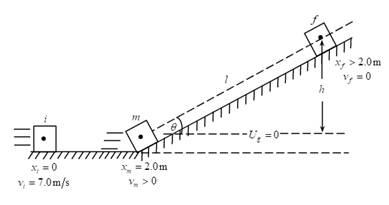
Concept explainers
(a)
The distance traveled by block along the incline plane.
(a)
Explanation of Solution
Given:
The mass of block is
The initial speed of block is
The coefficient of friction is
The angle of incline with the horizontal is
Formula used:
Write the expression for friction force along the incline.
Here,
Write the expression for thermal energy.
Here,
Substitute
Write the expression for change in potential energy.
Here,
Write the expression for change in kinetic energy.
Here,
Total energy of block is conserved at all points. Work done by external force is equal to the sum of change in gravitational potential energy, kinetic energy and thermal energy.
Write the expression of work done by external force.
Here,

There is no external force acting on the block; so, the work done by external force is zero.
Substitute
Substitute
Calculation:
Substitute
Conclusion:
Thus, the distance traveled by block along the incline is
(b)
The speed of the block when it has traveled half the distance in part (a).
(b)
Explanation of Solution
Given:
The mass of block is
The initial speed of block is
The coefficient of friction is
The angle of incline with the horizontal is
Formula used:
Write the expression for friction force along the incline.
Here,
Write the expression for thermal energy.
Here,
Substitute
Write the expression for change in potential energy.
Here,
Write the expression for change in kinetic energy.
Here,
Total energy of block is conserved at all points. Work done by external force is equal to the sum of change in gravitational potential energy, kinetic energy and thermal energy.
Write the expression of work done by external force.
Here,

There is no external force acting on the block; so, the work done by external force is zero.
Substitute
Substitute
For object velocity at halfway on incline plane:
Substitute
Substitute
Calculation:
Substitute
Conclusion:
Thus, the speed of the block when it has traveled half the distance in part (a)is
Want to see more full solutions like this?
Chapter 7 Solutions
Physics for Scientists and Engineers
- An object is placed 24.1 cm to the left of a diverging lens (f = -6.51 cm). A concave mirror (f= 14.8 cm) is placed 30.2 cm to the right of the lens to form an image of the first image formed by the lens. Find the final image distance, measured relative to the mirror. (b) Is the final image real or virtual? (c) Is the final image upright or inverted with respect to the original object?arrow_forwardConcept Simulation 26.4 provides the option of exploring the ray diagram that applies to this problem. The distance between an object and its image formed by a diverging lens is 5.90 cm. The focal length of the lens is -2.60 cm. Find (a) the image distance and (b) the object distance.arrow_forwardPls help ASAParrow_forward
 Physics for Scientists and Engineers: Foundations...PhysicsISBN:9781133939146Author:Katz, Debora M.Publisher:Cengage Learning
Physics for Scientists and Engineers: Foundations...PhysicsISBN:9781133939146Author:Katz, Debora M.Publisher:Cengage Learning Glencoe Physics: Principles and Problems, Student...PhysicsISBN:9780078807213Author:Paul W. ZitzewitzPublisher:Glencoe/McGraw-Hill
Glencoe Physics: Principles and Problems, Student...PhysicsISBN:9780078807213Author:Paul W. ZitzewitzPublisher:Glencoe/McGraw-Hill Classical Dynamics of Particles and SystemsPhysicsISBN:9780534408961Author:Stephen T. Thornton, Jerry B. MarionPublisher:Cengage Learning
Classical Dynamics of Particles and SystemsPhysicsISBN:9780534408961Author:Stephen T. Thornton, Jerry B. MarionPublisher:Cengage Learning University Physics Volume 1PhysicsISBN:9781938168277Author:William Moebs, Samuel J. Ling, Jeff SannyPublisher:OpenStax - Rice University
University Physics Volume 1PhysicsISBN:9781938168277Author:William Moebs, Samuel J. Ling, Jeff SannyPublisher:OpenStax - Rice University Principles of Physics: A Calculus-Based TextPhysicsISBN:9781133104261Author:Raymond A. Serway, John W. JewettPublisher:Cengage Learning
Principles of Physics: A Calculus-Based TextPhysicsISBN:9781133104261Author:Raymond A. Serway, John W. JewettPublisher:Cengage Learning College PhysicsPhysicsISBN:9781285737027Author:Raymond A. Serway, Chris VuillePublisher:Cengage Learning
College PhysicsPhysicsISBN:9781285737027Author:Raymond A. Serway, Chris VuillePublisher:Cengage Learning





